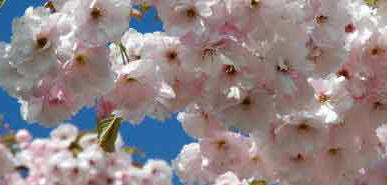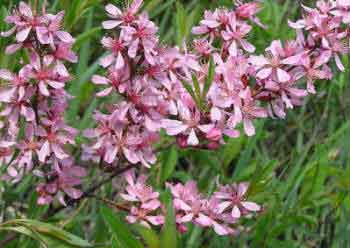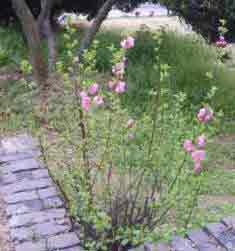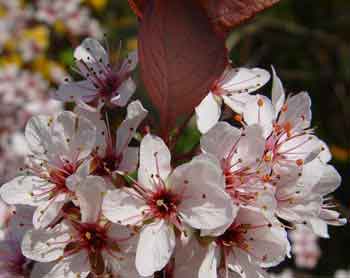Prunus – Flowering Ornamental Cherries, Almonds and Plums.
How to grow Ornamental Cherries as Shrubs.
Normally when we think of Prunus or flowering cherries, there is a vision of masses of pink or white blossom on roadside trees or in public parks in late spring or early summer - generally leaving a carpet of pink or white flowers on the lawn after their short but welcome flowering period. Not too many in private gardens - though some.
The Ornamental Prunus group, consist of three main sub-sections, being Almonds, Plums and Cherries. Commonly – though wrongly – called Flowering Cherries.
The Prunus we talk of in this section are a wide and varied range of shrubs, for many of the Prunus are indeed small to medium size shrubs with a wide range of uses. As well as the flowering cherry types, there are assorted evergreen Prunus normally grouped under the common name of Laurels.
The difference between the 'tree' Prunus and the 'shrub' Prunus being that the shrubs have many branches starting at or near ground level, whilst the trees are branched on top of a single stem. If we define the difference between trees and shrubs by ultimate size, we run into a few problems, for several Prunus are grafted on a single stem at or near ground level, then radiate outwards and upwards to the height of a few meters.
 Stem bark can often be a feature with the tree versions of flowering
cherries, but less so with the shrub types.
Stem bark can often be a feature with the tree versions of flowering
cherries, but less so with the shrub types.
Most flowering cherries are deciduous, but there are also evergreen types – generally classed as Laurels – which are very useful for ground cover, screening and hedges. The evergreens also have attractive flowers, normally white or cream, and quite different from the normal perception of flowering cherries.
Grouping them into two groups - ‘evergreen’ and ‘deciduous’ - works quite well for descriptive purposes, for both types have their own distinctive characteristics.
Most of the shrubby-type flowering cherries are propagated by budding or grafting onto a wild sherry stem, either at ground level or just above. They are difficult to root from cuttings – some impossible. This way they grow into attractive shrubs, sometimes with flower all the way up the stems.
The evergreen types can be propagated in the normal manner of stem cuttings and root quite easily at various times of the year.
Flowering Ornamental Cherry (Prunus) Shrubs.
There are a few shrub Prunus that should be better known and more often planted in gardens. It is probably the fact that they have a relatively short flowering period that is their undoing. Most stay within reasonable bounds for even small gardens, and will in any event respond rather than react to pruning to size.
The Prunus shrubs - as with their tree cousins - encompass Ornamental Plums, Almonds and Cherries. They are all part of the wider Prunus genus.
Prunus tenella
 Prunus
tenella 'Fire Hill'
is one of the Almonds in the Prunus group that almost caused me an
accident whilst driving. (It was far too noticeable in an otherwise
dreary garden border at the side of the road.)
Prunus
tenella 'Fire Hill'
is one of the Almonds in the Prunus group that almost caused me an
accident whilst driving. (It was far too noticeable in an otherwise
dreary garden border at the side of the road.)
Prunus tenella is one of the first of the shrub cherries to flower - as early the end of March - and it a mass of dark pink flowers on a rather untidy but upright bush. The pink flowers eventually give way to almond fruits, with the nuts inside. They are however best grown for their floral rather than edible traits, for the nuts rarely come to anything of substance.
Height and spread can eventually extend to 1.5m, but slowly after a rapid start. Following the flowering period, the shrub is nothing but foliage of a dark green nature. But the flowers and flowering time make it a good inclusion in border or as a hedge.
Prunus triloba
 Prunus
triloba is another shrub form of the
flowering cherries - but again is an Almond - that is a favourite
- perhaps because I always managed to sell a few hundred every spring in
an earlier life!
Prunus
triloba is another shrub form of the
flowering cherries - but again is an Almond - that is a favourite
- perhaps because I always managed to sell a few hundred every spring in
an earlier life!
Prunus triloba - so called because of sometimes bearing three-lobed leaves - is a spectacular early to mid-spring flowering shrub, with a densely branched habit that can be improved by pruning, of which later. Light pink very double bowl shaped flowers along stems which can be persuaded to grow quite erect. The flowers are followed by pinking sphere-like fruits which are the seed covering. Non-edible as far as I am aware. Foliage is mid-green for the remainder of the growing season and reasonable attractive, but with no autumn colour to enhance.
As a shrub - it can also me a small standard tree - it is normally budded onto a short wild cherry rootstock close to the ground. It sends out straight erect shoots or branches - especially if pruned immediately after flowering. Cut back half of the growth each year.
In the image, you can see where the pruning cuts have been made. In this instance not right after flowering, so the new shoots did not have time to grow flower buds throughout the summer - resulting in just a few flowers at ends of branches.
Any soil, but a full sun or dappled shade position will suit. Very attractive, and if pruned as above each year, will remain 1.4m height and spread.
The best of the forms is Prunus triloba 'Multiplex' - having very double, rich pink flowers.
Prunus x cistena.
 This
- the dwarf Purple Plum - is a bright, but dark red leaved, cousin of
the large purple leaved charry often seen growing in large parks,
roadsides, or large gardens. The tree form is Prunus cerasifera
'Pissardii'. It is a purple foliaged Plum member of the Prunus family.
This
- the dwarf Purple Plum - is a bright, but dark red leaved, cousin of
the large purple leaved charry often seen growing in large parks,
roadsides, or large gardens. The tree form is Prunus cerasifera
'Pissardii'. It is a purple foliaged Plum member of the Prunus family.
Prunus x cistena is one of its offspring, and bears many of the attributes of its parent, with the main exception being that it is a shrub and not a tree. As well as the attractive purple foliage throughout the summer, it bears masses of delicate lightest pink flowers on bare branches in early spring, which often hold well until the bright red new foliage starts to shoot.
Prunus x cistena is a slow growing shrub, attractive for much of the year with the foliage that follows on from the flowers. It is more tolerant of light shade or even woodland situation than the two previous types mentioned.
This ornamental plum is not invasive, though can send up sucker-like growth as it matures - forming a thicket. Prunus x cistena rarely needs pruning and is generally best left alone.
Dark red purple fruits (plums, but do not eat) are also a talking point, but no more than mildly attractive.
1.5m height and spread in around 8-10 years makes it a good choice for garden, or as a very attractive screen hedge.
Problems with Prunus shrubs.
Aphids are a bit troublesome, but can normally be ignored. Other than that, the normal disease of Prunus such as silver leaf is rarely a problem.
Propagation of prunus shrubs is normally carried out by budding and not normally the preserve of the occasional gardener. Prunus x cistena can be rooted from cuttings – hardwood in particular - but is not easy to grow through the first winter after rooting.
Another Prunus sometimes sold as a shrub - though larger then the three mentioned here is Prunus x subhirtella 'Autumnalis'
Best Selling Gardening Products
Popular Gardening Sections

Problems
Identify Weeds in The Garden - How to deal with weeds. Diseases and Pest which harm your garden and plants, learn how to prevent, deter and erradicate your garden problems.
Garden Problems
Pruning
Pruning Guide. Shrubs flower better with correct pruning. Many illustrations and examples of what to do - and when. Includes evergreens, roses, flowering shrubs, spring flowering shrubs and pruning for stem effect. This is our most viewed and comprehensive section,
Pruning
Gardening Businesses
Gardening Businesses listed in the UK counties and USA states. County and State Listings of businesses involved in Garden supplies and services. If you wish to be added to the Directory, please send us your information. Having problems, use the search box
Businesses
Gardening
In this section you will learn about Gardening Basics, Containers, Landscaping, Propagation and Soil.
Gardening
Gardening Gifts
Gardening Gifts and Reviews, Read Before you Buy
- Gardening Gifts Ideas
- Gifts For Her
- Gifts For Men
- Power Tool Gifts
- Cheap Gifts
- Personalised Gifts
- Wildlife Gifts
- Family Gifts



